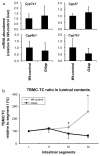Conditional Gata4 deletion in mice induces bile acid absorption in the proximal small intestine
- PMID: 20581237
- PMCID: PMC2981798
- DOI: 10.1136/gut.2009.204990
Conditional Gata4 deletion in mice induces bile acid absorption in the proximal small intestine
Abstract
Background and aims: The transcription factor GATA4 is expressed throughout most of the small intestine except distal ileum, and restricts expression of the apical sodium-dependent bile acid transporter (ASBT), the rate-limiting intestinal bile acid transporter, to distal ileum. The hypothesis was tested that reduction of GATA4 activity in mouse small intestine results in an induction of bile acid transport in proximal small intestine sufficient to restore bile acid absorption and homeostasis after ileocaecal resection (ICR).
Methods: Bile acid homeostasis was characterised in non-surgical, sham or ICR mice using two recombinant Gata4 models in which Asbt expression is induced to different levels.
Results: Reduction of intestinal GATA4 activity resulted in an induction of ASBT expression, bile acid absorption and expression of bile acid-responsive genes in proximal small intestine, and a reduction of luminal bile acids in distal small intestine. While faecal bile acid excretion and bile acid pool size remained unchanged, the bile acid pool became more hydrophilic due to a relative increase in tauro-beta-muricholate absorption. Furthermore, proximal induction of Asbt in both Gata4 mutant models corrected ICR-associated bile acid malabsorption, reversing the decrease in bile acid pool size and increase in faecal bile acid excretion and hepatic cholesterol 7alpha-hydroxylase expression.
Conclusions: Reduction of intestinal GATA4 activity induces bile acid absorption in proximal small intestine without inducing major changes in bile acid homeostasis. This induction is sufficient to correct bile acid malabsorption caused by ICR in mice.
Conflict of interest statement
Figures








References
-
- Hofmann AF. Bile acid malabsorption caused by ileal resection. Arch Intern Med. 1972;130:597–605. - PubMed
-
- Shneider BL. Intestinal bile acid transport: biology, physiology, and pathophysiology. J Pediatr Gastroenterol Nutr. 2001;32:407–17. - PubMed
-
- Vanderhoof JA, Langnas AN. Short-bowel syndrome in children and adults. Gastroenterology. 1997;113:1767–78. - PubMed
-
- Smith LH, Fromm H, Hofmann AF. Acquired hyperoxaluria, nephrolithiasis, and intestinal disease. Description of a syndrome. N Engl J Med. 1972;286:1371–5. - PubMed
-
- Pitt HA, Lewinski MA, Muller EL, et al. Ileal resection-induced gallstones: altered bilirubin or cholesterol metabolism? Surgery. 1984;96:154–62. - PubMed
Publication types
MeSH terms
Substances
Grants and funding
LinkOut - more resources
Full Text Sources
Other Literature Sources
Molecular Biology Databases
